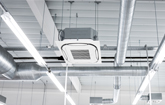The ABCs of Indoor Air Quality in Schools
Solve the Indoor Air Quality Equation with Identified Risks and Targeted Solutions
READING, Pa., Sept. 22, 2021 /PRNewswire/ -- Children spend approximately 1,300 hours a year inside United States public school buildings, adding up to 17,000 hours over the course of a normal thirteen year school career. With more than 48 million school-aged children and millions of teachers and staff attending these schools every year, the state of indoor air quality has never been more important.
According to the National Center for Education, nearly 50 percent of United States school buildings reported having issues with indoor air quality. Out-dated school buildings, urban pollution, congested classrooms and toxins from school supplies and cleaning products have a direct impact on the overall quality of air inside schools.
To fully address these issues, school officials must first understand the risks associated with poor indoor air quality. Matt Hayas, Director of Product and Innovation at Ambius, identified three risk factors, the impacts they can have and provided key tips for solving indoor air quality problems.
A - Asthma and Allergens
According to the Environmental Protection Agency, nearly 1 in 13 school-aged children suffers with asthma. Asthma related symptoms can lead to chronic illness in children and is responsible for more than 14 million missed school days each year.
Exposure to dust, mold, pollen and other common indoor allergens can have long-term impacts on children with vulnerable and developing lung systems. Common symptoms of indoor allergen exposure include: headaches, cough, sore throat, fatigue and more, all of which can trigger and negatively impact learning, attendance and productivity.
B - Bad Odors
The National Center for Education reported that nearly 70 percent of public school students attend schools in either urban or suburban areas. These schools are surrounded by industrial air pollution, bus and vehicle exhaust fumes and other environmental hazards that seep into school buildings everyday. Outdoor air pollutants produce dirty, musty odors and are extremely harmful to children.
Everyday school supplies and cleaning products also release toxins into the air, emitting strong, chemical-like smells. Indoor air pollutants can sometimes be difficult to see, but strong, musty odors are a tell-tale sign that the quality of the indoor air is compromised. Aside from the foul smell, these outdoor and indoor fumes and chemicals can have a significant impact on respiratory and lung health for children.
C - Cross Contamination
Children are known to play an accelerated role in the spread of respiratory viruses between peers. Crowded spaces like classrooms, corridors, and school assemblies where the breathing zones of occupants overlap also increases the risk of cross-infection of airborne viruses amongst school-aged children.
Viral particles can linger in the air for hours after being emitted, making proper airflow control a critical step in preventing cross-contamination. School buildings and classrooms without proper ventilation pose an extreme health risk for students and staff.
The Cost Impacts of Poor Indoor Air Quality
If the severe health implications in which poor indoor air quality exposure can have on students and staff isn't enough of a wakeup call, school officials should also consider the cost implications of student and teacher absenteeism.
According to Education Data, an estimated $10.7 billion dollars are lost each year due to student absenteeism in the United States. This total does not include teacher absenteeism, or the associated costs of hiring substitute teachers. When schools invest in improving indoor air quality it will have a direct impact on student and teacher health, resulting in fewers days missed and lessening the financial burdens of student and teacher absenteeism.
Solutions to the Problems
While traditional Heating, Ventilation and Cooling (HVAC) units and air purifiers help to better circulate the air, many lack the ability to fully decontaminate airborne pathogens, leaving behind allergens, bad odors and a risk of cross contamination. Air decontamination units, such as VIRUSKILLER™, take air purification a step further by filtering, neutralizing and decontaminating harmful airborne pathogens. They do this by drawing contaminated air away from the breathing zone, through a triple layer of filters and then move it into the patented UV-C Reactor Chamber, deactivating 99.9999% of airborne viruses in a single air pass .
Not only will these units protect the overall health and well-being of students, teachers and staff, VIRUSKILLER also incorporates real-time indoor air quality monitoring displays to serve as a visual cue that the air is clean, pure and safe. Real-time indoor air quality monitoring displays help to track the current state of the indoor environment. These monitors should be prominently displayed on the front of the air purifying unit. For schools, indoor air quality monitors with clear, real-time displays will provide peace of mind for administrators and will demonstrate to students, parents and teachers that their health, safety and well-being are a top priority.
For more information on the importance of indoor air quality, or to learn more about VIRUSKILLER™, please visit the Ambius website.
CONTACT: Erin Kelly, 919-815-2940, [email protected]
SOURCE Ambius

WANT YOUR COMPANY'S NEWS FEATURED ON PRNEWSWIRE.COM?
Newsrooms &
Influencers
Digital Media
Outlets
Journalists
Opted In




Share this article